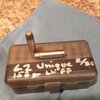AJC1
Member
It was the go to.powder for many years and was always available kinda like tightgroup is on every shelf now. I love me some unique but if I'm looking for magnum power I choose 2400. This being a load what you can get scenario the list above was comprehensive. I see ramshot enforcer on the shelf now and #2 only at sportsmans. That choice is easy.Thanks to all who responded.
My Lee manual lists 6.0 grains as the maximum for Unique under a 158 grain cast lead bullet. Please, which manual or reference allows 6.5 grains of Unique?
I am surprised that the oldest powder in the bunch is so highly recommended for .357 Magnum loads. When I posted my question, I was expecting one of the newer powders to get the nod. But your responses showing overwhelming preference for Unique is certainly convincing. I will give it a try and if I get impressive groups I will post pictures.
Thanks again for the help.





